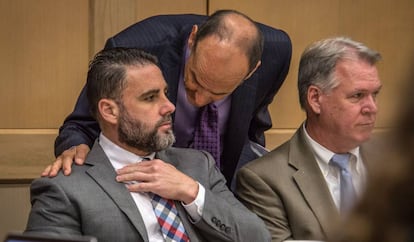Convicted murderer Pablo Ibar escapes capital punishment in Florida
After already having spent years on death row, the American with Spanish nationality has been given life imprisonment for a 1994 triple murder, and plans to appeal this latest ruling


Spanish citizen Pablo Ibar has been spared the death penalty and sentenced to life in prison by a US court in Florida. Ibar, who is of Spanish descent on his father’s side, has been behind bars for 25 years, 16 of them on death row, for the brutal killing of a bar owner and two dancers inside the former’s house in Broward County, Florida in 1994. The case became known as the “Casey’s Nickelodeon murders,” in reference to the name of the male victim’s place of business.
Life imprisonment is not the most compassionate sentence that exists but it is a tiny step in the right direction
Defense lawyer Kevin Kulik
Ibar’s family was present in the courtroom and cried and hugged each other when they heard the sentence read out on Wednesday. His family have been a rallying force for Ibar, providing crucial testimony to support his case.
“It’s a triumph,” said his father Cándido Ibar, a Basque jai-alai player who emigrated to the US in the 1960s, as he left the courtroom in Fort Lauderdale. “While there is life, there is hope,” he added.
“Pablo has been saved by the people whose lives he made a difference to,” said Ibar’s wife Tanya Quiñones, who was 15 when Ibar was arrested in 1994. “The fight continues but this is a small victory in the right direction.”
In January of this year, Ibar was found guilty for a second time of the 1994 triple murder. But in an unexpected twist, one of the jurors who found him guilty reconsidered their decision a few days later. That same jury was given the option to sentence Ibar to the death penalty or life imprisonment.
Before leaving the courtroom, Ibar looked at his lawyers and family, and with his hand on his heart, said thank you
“In this case, you are all eyewitnesses to a 22-minute nightmare that ended the lives of Casey [Sucharski], Marie [Rogers] and Sharon [Anderson]," said Katya Palmiotto, from the prosecutor's team in the four-day trial.
The prosecutor showed the court security camera footage from June 27, 1994 that was taken from the home of victim Casimir “Butch Casey” Sucharski. In the grainy, black-and-white video, two individuals are seen killing the three victims in cold blood. At the end of the video, one of the culprits takes off the shirt covering his head, revealing a face with a resemblance to Ibar’s. The video and the shirt were key evidence in the January trial, which led to a second guilty verdict.
“This is what the real Mr Ibar does when nobody is watching,” said Palmiotto in an effort to counter the positive character portraits provided by Ibar’s family.
Defense lawyer Kevin Kulik tried to present the trial as a “decision between life and death.” The lawyer read testimony from Alex Sucharski, the daughter of one of the victims, who spoke of how much she suffered when she lost her father. Kulik reminded the jury that their decision was to be made on an individual basis: if one opposed, there would be no death penalty. “Life imprisonment is not the most compassionate sentence that exists but it is a tiny step in the right direction,” he said.
While there is life, there is hope
Cándido Ibar, father of Pablo
The jury withdrew at 4pm to deliberate and returned an hour later with their verdict: life imprisonment. Before Ibar was handcuffed and led out of the courtroom, he stood up, looked at his lawyers and family, and with his hand on his heart, said thank you.
The next step is to appeal to the Florida Fourth District Court of Appeal. If that appeals fails, Ibar will appeal again to the Florida Supreme Court.
Trial history
This latest trial marked the fourth for Ibar, whose first time inside a courtroom, in 1997, ended in a hung jury. He was found guilty and sentenced to death in 2000, then won a Florida Supreme Court battle to be granted a retrial on the basis that his court-appointed counsel had mounted a flawed defense.
In 2016, the Florida Supreme Court also wrote that there was a lack of physical evidence connecting Ibar to the triple murders. Ibar’s DNA was not found on a blue T-shirt recovered from the crime scene, and which partially covered the face of the perpetrator according to grainy surveillance camera footage. None of the blood, hair and saliva samples recovered in the investigation match Ibar either.
The story has been widely followed in Spain, where a Pablo Ibar Association Against the Death Penalty was set up to raise funds for his defense. Ibar was born in South Florida and took Spanish citizenship after being convicted in 2000, according to The Miami Herald.
Death penalty in the US
Since 1973, 165 people have been freed from death row, 29 of them in Florida. There are currently 2,721 inmates on death row in the United States, 354 of those in Florida. Since the beginning of 2019, seven people have been executed across the 30 US states that still have the death penalty.
The state of Florida spends $51 million more a year enacting the death sentence than it would punishing first-degree murders with life imprisonment. Eighty-eight percent of present and past head of criminology academies agree that the death penalty does not act as a deterrent to murder. According to a report by the Federal Bureau of Intelligence (FBI), the south of the United States, where 80% of state executions take place, has the highest murder rate, while the northeast of the country, where there less than 1% of executions are performed, has the lowest murder rate.
English version by Melissa Kitson.
Tu suscripción se está usando en otro dispositivo
¿Quieres añadir otro usuario a tu suscripción?
Si continúas leyendo en este dispositivo, no se podrá leer en el otro.
FlechaTu suscripción se está usando en otro dispositivo y solo puedes acceder a EL PAÍS desde un dispositivo a la vez.
Si quieres compartir tu cuenta, cambia tu suscripción a la modalidad Premium, así podrás añadir otro usuario. Cada uno accederá con su propia cuenta de email, lo que os permitirá personalizar vuestra experiencia en EL PAÍS.
¿Tienes una suscripción de empresa? Accede aquí para contratar más cuentas.
En el caso de no saber quién está usando tu cuenta, te recomendamos cambiar tu contraseña aquí.
Si decides continuar compartiendo tu cuenta, este mensaje se mostrará en tu dispositivo y en el de la otra persona que está usando tu cuenta de forma indefinida, afectando a tu experiencia de lectura. Puedes consultar aquí los términos y condiciones de la suscripción digital.
More information
Archived In
Últimas noticias
Mexico seeks to shore up its defenses following US incursion in Venezuela
Hope gives way to uncertainty among Venezuelan exiles in the US after Maduro’s capture
Cubans look to Venezuela fearfully after Trump’s incursion: ‘We could be next’
The operation in Venezuela to capture Maduro threatens to widen the cracks in the MAGA movement
Most viewed
- Alain Aspect, Nobel laureate in physics: ‘Einstein was so smart that he would have had to recognize quantum entanglement’
- Alvin Hellerstein, a 92-year-old judge appointed by Bill Clinton, to preside over Maduro’s trial in New York
- Gilles Lipovetsky: ‘If you want to live better and fall in love, take Prozac, don’t look to philosophy’
- Cuba confirms death of 32 of its citizens in the US attack against Venezuela
- Why oil has been at the center of Venezuela-US conflicts for decades










































